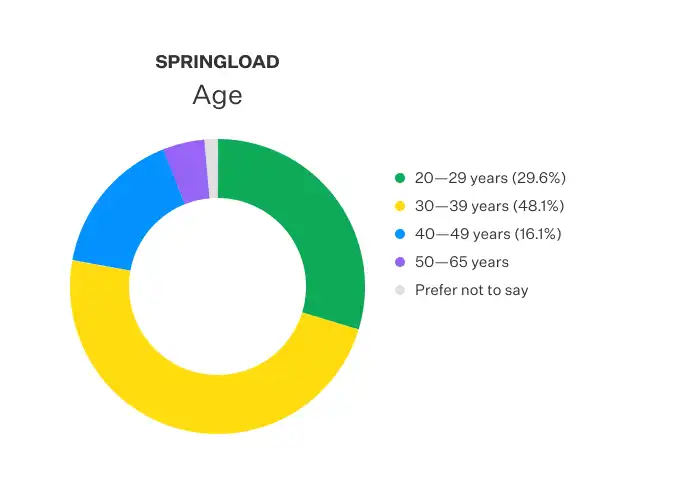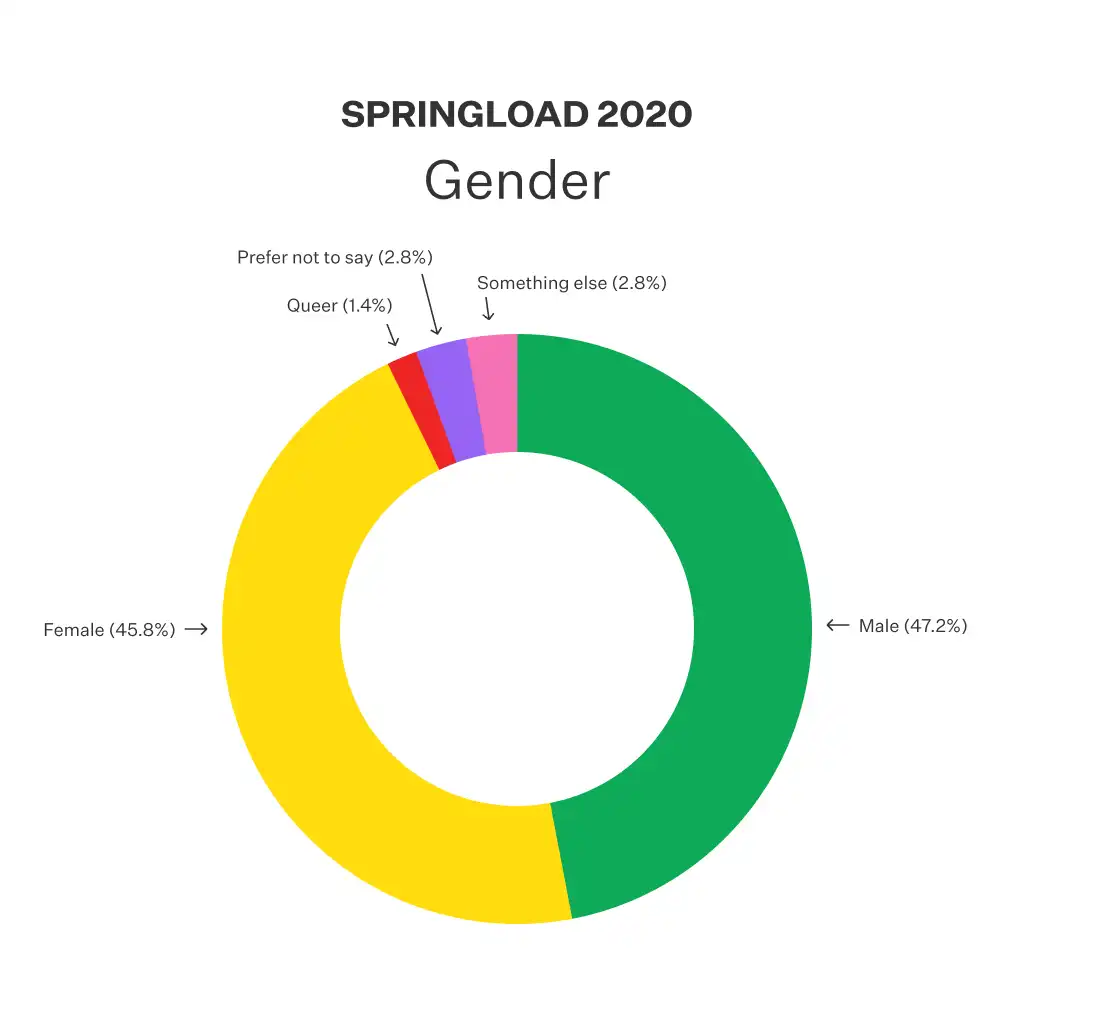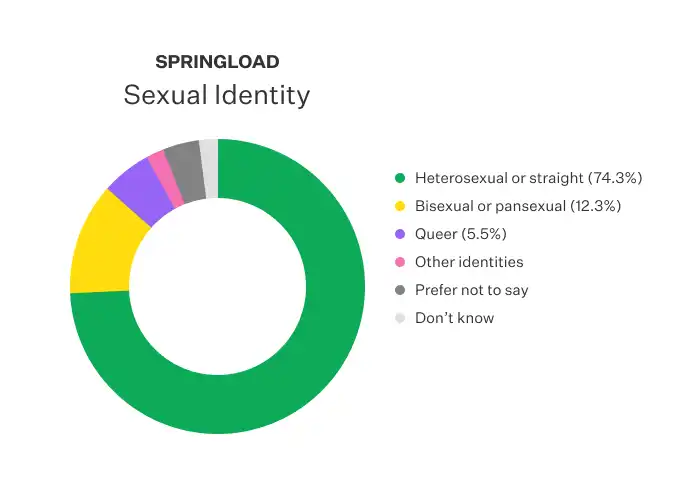
In this blog we’ll review the results of Springload’s survey, the key insights we’ve pulled, and how that’s shaped our diversity and inclusion (D&I) plan for the next 12 months.
Earlier this year we conducted a baseline diversity survey to:
- understand diversity at Springload
- have metrics to work with so we could compare to the general population of New Zealand and determine whether our diverse range of service users are adequately represented at Springload
- set future goals with improvements that are measurable and tangible.
Our diversity results
We’ve compared the results from our diversity survey with New Zealand’s 2018 census data so we can see how well we represent Aotearoa. All of the data is anonymous and shown in proportional pie charts so the relationships between each category of results is clear. Smaller value percentages are unlabelled.




of
Like a lot of digital companies, we skew a bit younger than the general population. In New Zealand, people aged 20-49 make up about ⅔ of the population. At Springload, that age group represents over ⅘ of our workforce.

Half of Springloaders identify as NZ European, similar to 56% of the NZ population recorded in 2018. But for key demographics that provide important cultural insights, specifically Māori and Pasifika, we are woefully under-represented.




of
According to Tech Women NZ , only 23% of the people working in technology are female. We are happy that our gender diversity is significantly above this, but we still have work to do to reach gender ratios that realistically reflect New Zealand’s population.




of
We have a vibrant rainbow community at Springload. The numbers from Stats NZ are an estimate as in 2018 this data was collated from the 2018 New Zealand Wellbeing survey. This is carried out via face to face interviews on people’s doorsteps and is therefore not wholly representative or conclusive data.
Walking the walk
The results from our survey have highlighted the areas we need to focus on to help us build and look after a diverse team.
Internal policies
Policies are a key part of diversity infrastructure — they set our intentions and expectations, not just for our current Springloaders, but for future Springloaders as well.
A goal for this year is for D&I to be commonplace throughout Springload — something people think about and discuss. We’re in the process of reviewing our policies for biases and intend to write new ones to support underrepresented groups. For example, we’re currently writing a policy specifically stating our commitment to looking after our rainbow team members.
Recruitment
We’re actively working on how we recruit new staff members and are always developing our process to ensure a fair and unbiased approach:
Extending our reach: we try to extend adverts into as many communities as possible, by posting in Māori and Pasifika spaces, working with recruiters who find placements for disabled people, and reaching out into women led spaces.
Using unbiased language: we avoid using words such as ‘ninja’ and ‘rockstar’ as research shows these can imply an overly masculine and aggressive work environment, so their use is very gendered and can be off putting to women. We also made an active choice to refer to 'primary caregiver leave', as opposed to 'maternity' or 'parental leave', to be more inclusive of different family structures.
- Restructuring our job ads: we now lead with information about Springload and what we can offer potential new recruits. This decision was based on research into how we could make our ads more appealing to Māori and Pasifika communities, where strong community and a supportive work environment are highly valued.
- Examining our interview criteria: to encourage diversity of thought, it’s important to realise that viewpoints outside of the dominant group bring value to a team. This is why we’ve been changing the way we think about how people will work at Springload — it’s important to avoid only hiring people who will be a ‘good fit’. We’ve learned that the concept of a ‘culture fit’ can be damaging in this space as it implicitly enables biased thinking about who can work well here.
Educational initiatives
Sometimes recruitment can’t address the imbalance in the tech sector — this is why we want to focus on more educational initiatives to:
encourage more Māori and Pasifika rangatahi into technology pathways. We’re investigating ways that we can showcase the benefits of a career in tech for rangatahi, their whānau, hapū and iwi
actively increase the number of women into tech. We have our own organisation, Grow, that works with women and non binary people who are interested in learning to code.
Team training
We’re working on increasing our cultural competency throughout Springload so different community groups feel included and valued. For example, we plan to provide Te Tiriti o Waitangi training to our whole team so that we can confidently embed these principles into the heart of all our work. We hope to incorporate a noho marae into our full induction process so that as an organisation we can authentically observe Māori tikanga and better understand and acknowledge our Māori team members, clients, and end users.
The future of D&I at Springload
At the end of this year we’ll be doing our second annual diversity survey. It will be amended and updated based on some excellent constructive recommendations we had after the inaugural round.
Our second survey will include a wider selection of answers in the ethnicity question and will also enable people to choose multiple options. We will also be exploring ways to discover more about our team’s cognitive diversity.
It’s exciting that we will soon have enough data to make comparisons and specific measurements to show where our efforts have made a difference. If you have any D&I tips you'd like to share with us, please get in touch.
Get in touch
Let’s make the things that matter, better.
Email: hello@springload.co.nz
Phone: +64 4 801 8205